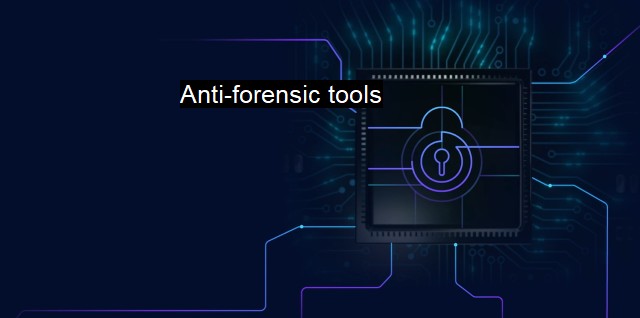What are Anti-forensic tools?
Anti-Forensic Tools: Staying Ahead of Cyber Criminals and Their Evolving Techniques to Hide Compromising Information
Anti-forensic tools refer to various software programs or techniques that are used to obscure, alter, or eliminate digital evidence from computer systems or networks to mitigate forensic investigations. These tools are often utilized by hackers, criminals, or malicious agents intending to avoid detection while engaging in criminal or unauthorized activities, thereby minimizing the chance of being traced or matched to a cybercrime incident.Understanding anti-forensic tools becomes critical as organizations establish their defense mechanisms and cybersecurity protocols. Traditional antivirus software and security systems rely primarily on identifying known threats, such as viruses, worms, and trojans, thereby safeguarding devices and networks. these conventional systems may often fail to recognize the more subtle, manipulative strategies employed through anti-forensic methodologies.
Anti-forensic tools primarily focus on tampering with computer systems' metadata, logging data, or file system data. They can confuse forensic toolsets and investigators by rearranging, anonymizing, or entirely deleting such crucial pieces of information - making it challenging to piece together a proper cybercrime timeline.
There are various types of anti-forensic tools used by malicious actors with differing levels of sophistication. At a basic level, tools like Secure Deletion or SDelete can overwrite existing files to prevent them from being recovered. Other tools can more comprehensively mask their activities; for instance, log cleaners can manipulate, rearrange, or entirely delete system logs, erasing any tracks of illegal actions.
On a more complex level, we have steganography tools, which involve hiding a file, message, image, or video within another file, message, image, or video. This does not alter the system or network proactively but makes it tough for investigators to fathom the traffic's actual contents. Steganography techniques, combined with encryption strategies, can effectively conceal information from forensic investigators.
There are also cases of using rootkits as anti-forensic tools. Passively, rootkits can hide files, processes, or system data; more nefariously, these can offer 'backdoor' access to a system, enabling long-term control over the system, all while remaining hidden from typical systems checks and antivirus software.
In combatting such tools, organizations must adopt a multifaceted approach to cybersecurity that doesn't rely solely on traditional virus and malware detection. Education and awareness about cybersecurity are pivotal. Both cybersecurity professionals and ordinary computer users need to understand potential vulnerability areas in their systems and the means by which these can be exploited.
Effective measures also include the active use of intrusion detection systems (IDS) and state-of-the-art antivirus systems, real-time application monitoring, timely patching of vulnerabilities, robust firewall configurations, and regular system checks. Similarly, utilizing steganographic detection tools can help identify any concealed information before considerable damage is done.
Adopting meticulous logging practices can counter the efforts of log cleaners. Logs must be immediately and automatically backed up to a secure, off-site/multiple locations, ensuring that even tampering on the system is recorded and not permanently lost. proactive cybersecurity measures, combined with a reactive recovery plan, can be instrumental in thwarting the impact of these anti-forensic tools.
The threat posed by anti-forensic tools is undeniably significant and continually evolving. To effectively neutralize the problems posed by these tools in this digital age, a sophisticated understanding of their modus operandi, combined with robust, dynamic cybersecurity strategies, is required. By incorporating such methods and constantly staying one step ahead of these threats, organizations can create an effective deterrent against malpractices like concealment and manipulation of digital evidence.

Anti-forensic tools FAQs
What are anti-forensic tools?
Anti-forensic tools are software applications designed to protect digital data from cybersecurity and antivirus analysis by deleting, modifying, or obfuscating evidence left behind by malicious actors.Who uses anti-forensic tools?
Anti-forensic tools are often used by individuals or organizations engaging in illegal activities that they wish to keep hidden from law enforcement or cybersecurity experts.Are anti-forensic tools illegal?
No, anti-forensic tools are not illegal in and of themselves. However, their use for illegal activities can result in criminal charges. Also, some anti-forensic tools may violate specific laws in certain jurisdictions.How can anti-forensic tools be detected?
Anti-forensic tools can be detected by experienced cybersecurity professionals using various techniques, including virus scans, file analysis, and memory forensics. The key is to identify any anomalies in the digital data that are not consistent with normal system behavior.| | A | | | B | | | C | | | D | | | E | | | F | | | G | | | H | | | I | | | J | | | K | | | L | | | M | |
| | N | | | O | | | P | | | Q | | | R | | | S | | | T | | | U | | | V | | | W | | | X | | | Y | | | Z | |
| | 1 | | | 2 | | | 3 | | | 4 | | | 7 | | | 8 | | |||||||